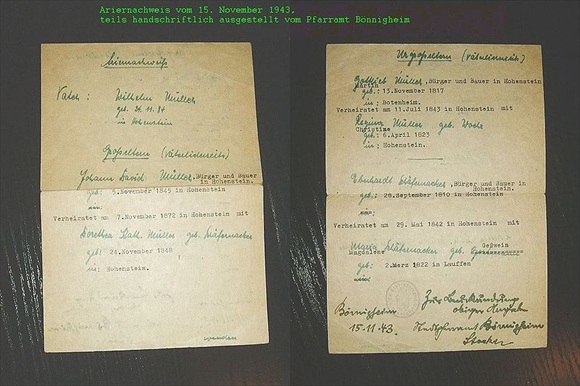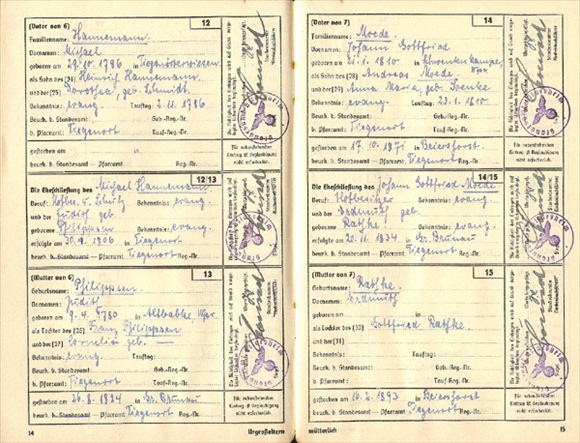REICHSTAG PASSES MORE ANTI-JEWISH LAWS
Berlin, Germany • April 7, 1933
Following his swearing in as chancellor on January 30, 1933, Adolf Hitler and his Nazi Party began a policy of Gleichschaltung (synchronization), whereby Germany would be thoroughly reordered along Nazi lines. With the Reichstag’s passage of the Enabling Act on March 23, 1933, signed into law by German president Paul von Hindenburg the same day, Hitler ruled by decree and the Nazi synchronization engine sprang to life.
On this date, April 7, 1933, compliant Reichstag members passed the Civil Service Restoration Act (Berufsbeamtengesetz), also known as the Aryan Act. This law reestablished a “national” and “professional” civil service and allowed tenured civil servants, with few exceptions, to be dismissed at all three levels of government—national (Reich), state (Laender), and municipal. Civil servants who had opposed the Nazi Party and its antidemocratic tactics and ideologies or who were not of pure Germanic descent (not “Aryans”; the term was defined the following week) were forced to retire. This meant that anyone who was suspected of being a political opponent of the Nazis and anyone who was even a quarter Jewish (attested by the Ariernachweis (see below), the required genealogical proof of Aryan ancestry that intruded into all areas of life) could not serve as teachers, professors, judges, or hold other government posts. Over a thousand Jews on the teaching staffs of German universities were abruptly cut off from their livelihoods. Shortly afterwards a similar law was passed covering lawyers, doctors, tax consultants, and public notaries. The Law Against the Overcrowding of German Schools and Universities placed limits on the number of Jews who could enroll or stay in state-supported schools.
In September and October Jews were further excluded from working in cultural and entertainment occupations, as well as in the field of journalism. The vicious raft of discriminatory legislation directed against Jews culminated in the 1935 Nuremberg Laws (Nuernberger Gesetze) “for the final separation of Jewry from the German Volk” (racial community). The areas of legitimate employment open to Jews (Voll-Juden) and “Jewish mixed-breeds” (Mischlinge) dwindled to next to nothing. Anyone with a trace of Jewish blood in his or her veins now found life and work in Germany next to impossible—which was the whole point. For their part ordinary Germans mostly accepted anti-Semitic legislation without protest owing to their deep respect for the law and their acceptance of Nazi racist ideology, us versus them.
The visible ostracism and persecution of Jews was ratcheted up with new legislation two years after Hitler had unleashed his genocidal war in Europe. From September 1941 the law obligated all Jews over the age of six, when out in public, to wear the Judenstern, or “Jewish star.” Fines or imprisonment were imposed on victims who broke the law or hid the star in any way. The next month rail cars left the Nazi capital for the East, the first in a series that carried thousands of Berliners to Jewish ghettos and labor and death camps in occupied territories. Between five and seven thousand Jewish Berliners avoided deportation by “diving” (tauchen) underground.
Two Documents that Attested to Non-Jewish Ancestry in Nazi Germany and Austria
 |
Above: An example of a Ariernachweis (Aryan Certificate), in this instance issued by the Stadtpfarramt Boennigheim (Catholic Parish Office of Boennigheim) in the state of Baden-Wuerttemberg. It certified that the person had no Jewish parents or grandparents. Beginning in April 1933 the Aryan Certificate was required of all employees and officials in the public sector, including education, under the Civil Service Act. In an ironic example of the Act’s chilling and deleterious effects on German academics (to say nothing about the outcome of World War II), Albert Einstein, being Jewish, did not return to his post as professor at the Berlin Academy of Sciences but extended his stay in the United States, becoming an American citizen in 1940. Outside the German civil service, the Act’s Aryan paragraph was inserted into the statutes of many federations, organizations, corporations, and real estate deeds, ultimately excluding Jews from all public life.
 |
Above: The pages in the Ahnenpass (Proof of Aryan Ancestry) documented the non-Jewish lineage of citizens of Nazi Germany and Austria. It was one of the forms of the Aryan Certificate. A proven Aryan lineage going back to all four grandparents was required for working in the professions, attending high school or the university, owning real estate, and even getting married. Nationals of other countries could acquire an Ahnenpass as long as they could prove to be of “German or racially equivalent blood.”
1933 Anti-Semitic Laws Enshrined in 1935 Nuremberg Race Laws
![]()

 History buffs, there is good news! The Daily Chronicles of World War II is now available as an ebook for $4.99 on Amazon.com. Containing a year’s worth of dated entries from this website, the ebook brings the story of this tumultuous era to life in a compelling, authoritative, and succinct manner. Featuring inventive navigation aids, the ebook enables readers to instantly move forward or backward by month and date to different dated entries. Simple and elegant! Click
History buffs, there is good news! The Daily Chronicles of World War II is now available as an ebook for $4.99 on Amazon.com. Containing a year’s worth of dated entries from this website, the ebook brings the story of this tumultuous era to life in a compelling, authoritative, and succinct manner. Featuring inventive navigation aids, the ebook enables readers to instantly move forward or backward by month and date to different dated entries. Simple and elegant! Click 











